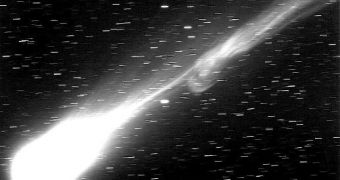After studying the 8P/Tempel comet, in order to determine its density, structure and composition characteristics, the Deep Impact spacecraft has recently been redirected on a trajectory that will take it on a two and a half years trip, to rendezvous with the Hartley 2 comet around the year 2010. Originally, the spacecraft's controllers wanted to send it to the 85P/Boethin comet, which has only been observed twice in recorded history, as it made two close approaches in the year 1975 and in 1986.
However, when astronomers pointed their telescopes towards the general area of the sky where calculations indicated that the comet would appear, they were shocked to discover that it was nowhere to be found, suggesting either that the comet's orbit has not been determined accurately, or that it has disintegrated during its latest approach to the Sun in 1997, when the comet was occulted by the glare of the Sun and was not visible from the surface of the Earth.
The possibility that the comet might have disintegrated during its latest pass is somehow remote, as the trajectory of its orbit never takes it closer to the Sun, than the orbit of Earth, meaning there is not enough information regarding its orbit to successfully encounter with Deep Impact in late 2008. Furthermore, the disintegration of the comet had to be followed by the observation of the remnant debris, such as those of the comet Linear-S4 which suffered a similar process in the year 2000, and the 73P/Schwassmann-Wachmann 3 in 2006, which were clearly well visible after their disintegration, followed by their disappearing in the immensity of space.
A third alternative theory suggests that the comet did disintegrate, in large pieces however, after which the debris might have fallen in an orbit far away from its original one, which has not been observed so far. Nevertheless, the most probable outcome is that the orbit has not been calculated accurately and astronomers are actually looking in the wrong portion of the sky.
After evaluating the alternative possibilities, flight controllers operating the Deep Impact probe decided to send it to comet Hartley 2, and on November 1st, the spacecraft started its journey, which also involved a scheduled fly-by around the planet Earth that will take place in the last day of this year, in order to make necessary trajectory corrections and to gather speed with the help of the planet's gravitational field.
With a nucleus about 1.6 kilometers across, the Hartley 2 comet is similar in dimensions with the Boethin comet; however, though the trip will take longer than that towards Boethin, Hartley presents a more active core. It is expected that the spacecraft will pass at an approximated distance of 1000 kilometers from the comet, to eliminate the risk of being damaged by debris ejected by the nucleus.
The Deep Impact spacecraft completed its original mission in 2005, after it observed the 8P/Tempel comet, and probed its structure by hitting it with an impactor. To avoid the complications of sending a new probe into space, NASA extended the mission under the name EPOXI, to study other comets. During the two years and a half, time in which the spacecraft will travel to the Hartley 2 comet, it will also have the mission to study light from stars passing in front of it, in order to determine whether or not they have planets orbiting them.
The method used by Deep Impact to detect the planets around other stars involves studying their light in the hope that variations in their brightness and light spectrum emissions would reveal new planets.

 14 DAY TRIAL //
14 DAY TRIAL //